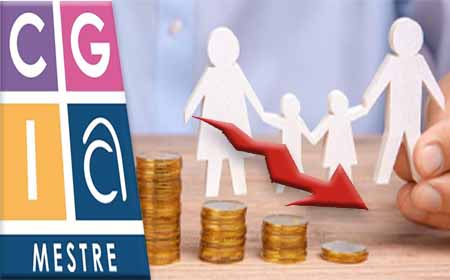In these two years of record inflation, the deposits of Italian households will suffer a "haircut" of 163,8 billion euros. How did this result come about? Firstly, the CGIA Research Office assumed that the 1.152 billion euros (data as at 31 December 2021) in bank current accounts have not recorded any changes in the time period taken into consideration. Secondly, after estimating that in the two-year period 2022-2023 inflation will grow by almost 15 percent (+8,1 last year and +6,1 this year), he calculated the loss of purchase of our savings. The result that emerged from this elaboration is “frightening”: we are practically faced with a patrimonial asset of almost 164 billion euros which will “cost” an average of 6.338 euros to each single household.
Bolzano, Milan, Trento, Lecco and Treviso are the most penalized provinces
At a territorial level, in the two-year period 2022-2023 the highest cost will be suffered by the families of the richest regions: in Trentino Alto Adige the loss of average purchasing power will be equal to 9.471 euros, in Lombardy 7.533, in Emilia Romagna 7.261 and in Veneto of 7.253.
At the provincial level, however, the "asset" will particularly affect families residing in Bolzano, who will suffer an average withdrawal of 10.542 euros. Milan follows with 8.500, Trento with 8.461, Lecco with 8.201 and Treviso with 7.948. The families least "affected", however, will be those located in the province of Syracuse with 3.842 euros, Trapani with 3.595 and Crotone with 3.130.
Subscribe to the PRP Channel newsletter
Amato's assets cost us 31 times less
More than 30 years later, many still remember with great indignation the extraordinary levy of 6 per thousand applied by the then Amato government on Italian current accounts. In the night between 9 and 10 July 1992, in fact, that measure cost Italian families 5.250 billion lire, or 2,7 billion euros. Discounting this amount, the withdrawal stands at 5,3 billion euros; practically an economic "sacrifice" 31 times lower than that estimated by the CGIA Research Office (163,8 billion euros) in the two-year period 2022-2023.
Now banks have to raise interest on deposits
With an interest rate charged by the ECB which stood at 2 per cent for almost the entire month last December, i.e. the same as we had in February 2009, what economic effects did it produce on a hypothetical current account holder? If 14 years ago the lending rate was 0,75 per cent, 2 months ago it stood at 0,12 per cent, "causing" a disadvantage for savers of 0,63 per cent. In other words, compared to 10 euros deposited in the current account, compared to 2009 we find ourselves with 63 euros less in a year. If, as many experts maintain, by the end of 2023 the rate rose to 4 per cent, reaching the same level reached between July 2007 and June 2008, on our hypothetical 10 thousand euros deposited in the bank we would lose 107 euros.
These are not important figures, however if the banks returned to recognizing a slight increase in lending rates on the free sums deposited in current accounts, customers could at least cover the fixed costs. Something, however, that has been practiced by institutions on fixed sums, even if, very often, for many current account holders to extricate themselves from a "sea" of offers is extremely difficult. An economic effort, the one that the banks would have to support if they adjusted the rates on unconstrained savings upwards, easily sustainable, given that things have gone very well in the last year. The five most important national institutions - Intesa, Unicredit, BancoBpm, Monte Paschi and Bper - closed 2022 with net profits of 12,7 billion. An increase of 65 percent compared to 2021 (Vittorio Malagutti, Rates on the rise banks in celebration, L'Espresso, number 7, 19 February 2023, pp. 66-71).
